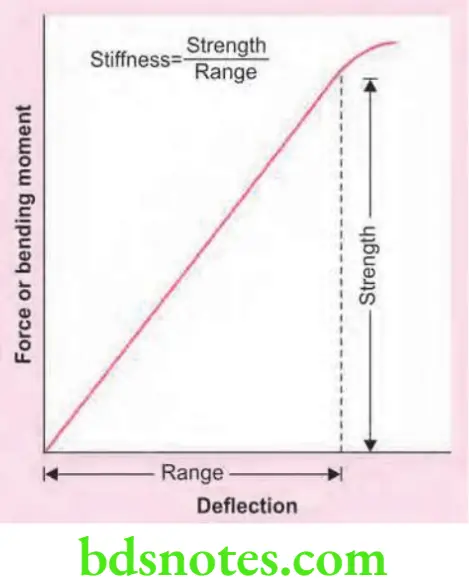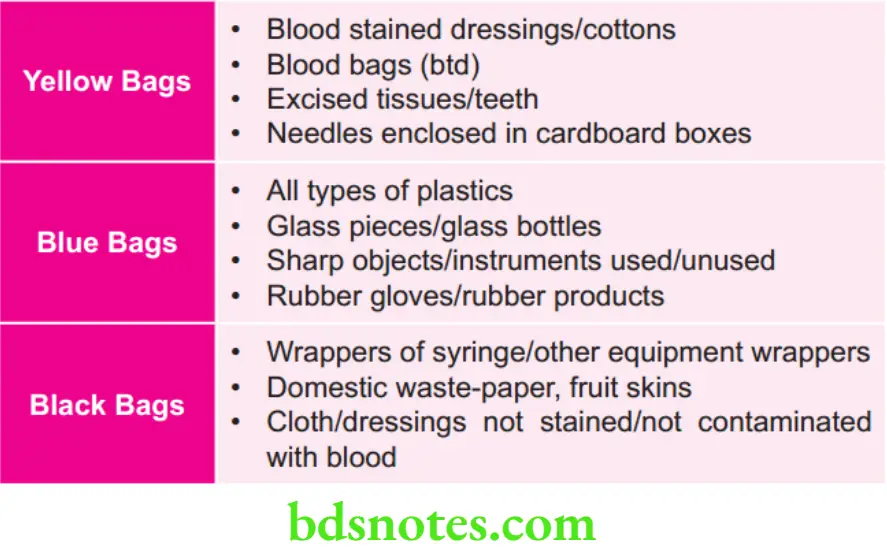Materials Used in Orthodontics
Question 1. Write short note on 18:8 stainless steel wire.
Or
Write short note on 18–8 stainless steel.
Or
Write short answer on stainless steel wire.
Or
Write short answer on 18:8 stainless steel.
Answer. Austenitic stainless steel wire is referred to as 18:8 stainless steel wire.
- It is used to make orthodontic arch wires.
- This wire is most corrosion resistant and hence widely used in dentistry.
- Both 302 and 304 Austenitic stainless steel are often called 18-8 stainless steel.
- Type 302 austenite is the basic alloy, which contains 17–20% chromium, 8–12% nickel and maximum of 0.15% carbon.
- Type 304 also has similar composition, but the carbon content is 0.08%.
- Type 316 L (low carbon) contains 16–18% chromium, 10-14% nickel. 0.03% carbon and is used for making implants.
- These wires have adequate strength, resilience, formability and adequate spring back. They are biocompatible and economical.
Read And Learn More: Orthodontics Question And Answers
Question 2. Write short note on ideal properties of orthodontic materials.
Or
Write briefly on properties of orthodontic wire.
Or
Write short note on ideal requisites of orthodontic wire.
Or
Enumerate properties of orthodontic wires.
Answer. The ideal properties of orthodontic material are as follows:
- Modulus of Elasticity
- The force applied to the teeth is for a given design and direction is directly proportional to the wire’s modulus of elasticity.
- Biologically, wire definitely has to deliver low constant force.
- Spring back
- Orthodontic materials should have low stiffness or good spring back.
- Arch wire should ideally possess high spring back which leads to increase in its range of action.
- It is also known as elastic deflection.
- It is a measure of how far an orthodontic wire can be deflected without causing permanent deformation.
- Stiffess
- Stiffess of arch wire should be low which produces lower and constant forces over the time.
- Resilience
- Resilience is the amount of force that the wire can absorb without undergoing permanent deformation.
- Arch wires should exhibit high resiliency to increase working range of appliance.
- Formability
- Formability represents the amount of permanent bending that the wire will tolerate before it breaks.
- The arch wire should exhibit high formability to withstand high forces.
- Ease of manipulation should be present.
- Ductility
- A ductile orthodontic wire/material can be formed into various shapes such as coils, loops, etc. without undergoing permanent deformation.
- Joinability
- The orthodontic wire should be easily joined by soldering and welding.
- Friction
- Orthodontic wire/material should provide least friction at wire bracket interface to avoid undue strain on anchorage and limitation of tooth movement.
- Biocompatibility
- Arch wire/Orthodontic material should be suited with oral tissues. It should not be toxic.
- Orthodontic material should be stable in oral environment
- Orthodontic material provide resistance to tarnish and corrosion
Question 3. Write short note on spring properties of orthodontic wire.
Answer. It is also known as elastic deflection.
- Orthodontic wire should have low stiffness or good springback.
- Arch wire should ideally possess high springback which leads to increase in its range of action.
- It is a measure of how far an orthodontic wire can be deflected without causing permanent deformation.
- It is related to the ratio of yield strength to the modulus of elasticity of material.
Question 4. Write short note on elastic properties of wire.
Answer. Elastic properties of a wire are its strength, stiffess and its range.
In the graph the stiffess is the slope of initial linear region; Force or moment at which yielding takes place is known as strength; Value of deflction of elastic limit is known as range.
Relationship between the elastic properties of wire is presented as:
\(\text { Stiffness }=\frac{\text { Strength }}{\text { Range }}\)Elastic properties of a wire are affected by change in its length and cross-section of wire.

Question 5. Write short note on bonding agents.
Answer. Bonding agents in orthodontics are used to attach bracket to the tooth/teeth. Currently, bonding agents bond to enamel and dentin.
- First generation (1950–1970): Mineral acids were used to etch enamel. Dentin etching was not applicable because of believe that it may harm pulp. Glycerophosphoric acid dimethacrylate is used. It is a bifunctional molecule. Hydrophilic phosphate reacts with calcium ions of hydroxyapatite. Hydrophobic methacrylate groups bonded to acrylic restorative resin. Major disadvantage was their low bond strength, i.e. 2–6 MPa.
- Second generation (1970s): Developed as adhesive agents for composite resins which had by then replaced acrylic restorations. One system used NPG-GMA (N-phenyl glycine glycidyl methacrylate). It was proposed that the NPG portion bonded to the calcium of the tooth by chelation. Other products included phenyl-P, 2-methacryloxy phenyl phosphoric acid. Bond strengths achieved were three times more than the earlier generations. Disadvantage: Bond strengths were still low. The adhesion was short term and the bond eventually hydrolyzed. Examples are: Prisma, Universal Bond, Clearfil, Scotch Bond.
- Third generation (1980s): Third generation bond agents deal with the smear layer which is formed when dentin is cut. It was believed that the smear layer prevented proper bonding to the underlying dentin. Complete removal by aggressive etching was contraindicated because it was believed that it protect pulp by preventing direct contact with the monomer. The third generation bond agents had bond strengths comparable to that of resin to etched enamel. Thus bond strengths improved to 12 to 15 MPa. Examples are: Tenure, Scotch bond 2, Prisma, Universal bond, Mirage bond, etc.
- Fourth generation (early 1990s): Fourth generation systems were possible because of some important ideological breakthroughs like the total etch technique and the development of the hybrid zone. Research showed that acid etching of dentin did not significantly harm the pulp as long as bacterial contamination and microleakage was avoided. Thus the total-etch technique was introduced. These bonding agents were applied in multiple steps. Examples are: All Bond 2, Scotch bond multipurpose, Optibond, etc.
- Fifth generation (mid 1990s): The fifth generation combined the primer and adhesive into one botte (self priming adhesive). Examples of the fit generation self-priming adhesives are Single Bond (SM ), One Step (BISCO), Prime and Bond (Dentsply).
- Sixth generation (mid to late 1990s): In this system a separate etchant is not required. These are 2 botte systems. Two varieties are seen, i.e. Type 1 and Type 2.
- Type 1 2 botte 2-step system. Etchant and primer are combined in one botte (called self etching primer). Other botte contains adhesive. Examples are Clearfil SE bond (Curare), Adhese (Ivoclair), Optibond solo plus (Kerr), Nano bond (Pentron), etc.
- Type 2 2 bottle 1 step system. Liquid A contains the primer. Liquid B contains a phosphoric acid modified resin (self-etching adhesive). Both liquids are mixed just before application. For example, Xeno 3 (Dentsply), Adper prompt L-pop (3M), Tenure imibond (Dent Mat), etc.
- Seventh generation (early 2000): Attempts to combine all three (etchant, primer and adhesive) into a single product. Thus, seventh generation adhesives may be characterized as ‘no mix self-etching adhesives. Examples include iBond (Heraeus Kulzer), G bond (GC), Xeno 6 (Dentsply) (glass ionomer based), Clearfi; S3 (Curare). Still efficacyy of the newer systems is to be determined.
Question 6. Write short note on archwire materials.
Answer. Archwire is one of the active components of fixed orthodontic appliances, which when used brings about various tooth movements (tipping, bodily, torque, rotational and vertical movements) through the medium of brackets and welded buccal tube on the palatal aspect of the molar bands.
Archwire Materials
- Gold
- Gold alloy were used in the manufacture of orthodontic archwire.
- Gold and gold alloy archwire exhibit excellent formability, environmental stability and biocompatibility.
- Main drawbacks of these arch wires include high cost, low springback and low yield strength.
- Stainless Steel
- Stainless steel archwire exhibit adequate strength, high resilience, formability, high stiffess, biocompatibility and economical.
- Drawback of these archwires includes high modulus of elasticity; more frequent activations are required to maintain the same force level.
- Nickel-Titanium Alloys
- Nickel titanium alloys, known as Nitinol (Nickel Titanium Naval Ordinance Laboratory), was invented by William R Buchler at Naval Ordinance Laboratory.
- Main advantage of this alloy over others is the high elasticity and shape back memory.
- Drawback of these archwires is that they cannot be welded or soldered and cannot receive bends or loops or helices.
- Beta-Titanium or TMA or CAN Wire
- Main advantages of these archwires include high range of action, high springback, receives bends, loops and helices and they can be welded or soldered.
- Cobalt-Chromium-Nickel Alloy
- Cobalt-Chromium-Nickel alloy is also known as Elgiloy.
- These wires exhibit excellent formability, jointability, springback and biocompatibility.
- Optiflx Archwire
- Optiflx archwires are composed of clear optical fibers and are therefore, highly esthetic.
- Drawback of these archwires is that they cannot receive sharp bends.
- Multistrand Archwire
- Multistranded arch wires are made up of a number of thin wires.
- They can be round or rectangular and braided or twisted and may have three strands or six strands.
- Main advantage of these archwires is that they exhibit increased flexibility.
Question 7. Write short note on biomedical waste management in dental clinic.
Answer. “Biomedical waste” means any waste which is generated during the diagnosis, treatment or immunization of human beings or animals or in research activities pertaining thereto or in the production or testing of biological, and including categories as mentioned in schedule I.
Management and Handling Rules, 1998 of India
- It may include wastes like sharps, soiled waste, disposables, anatomical waste cultures, discarded medicines, chemical wastes, etc.
- This waste is potentially hazardous, the main hazard being infection, and may pose a serious threat to human health if management is indiscriminate and unscientific.
- Biomedical wastes in dental clinics should be segregated into different categories according to its disposal systems.
- Various biomedical waste carriers/bags are used for collection which are color coded and are used for the collection of specific type of biomedical waste.
- Three types of bags are used in the clinics with the biohazard symbol, i.e.

Once all the bags are full, the biomedical waste should be disposed by contacting a certifid biomedical waste carrier.

Leave a Reply